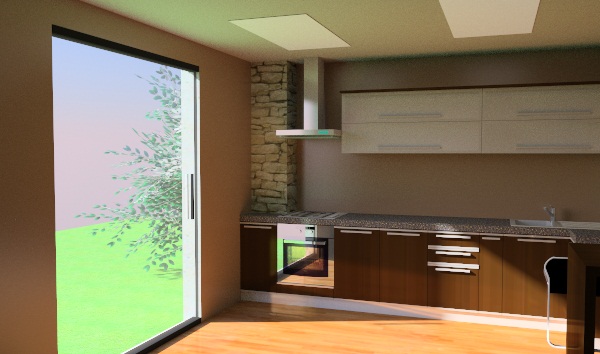nXtRender Rendering Engines
There are three rendering engines. - Packet Mode (biased), the Path Tracer (unbiased), and Engine 4 (Hybrid).
Packet Mode, a biased rendering engine, is the fastest method for creating renderings. It does this by making some assumptions about light, reflection, and transparency solutions. The unbiased engines use more precise algorithms that process each individual pixel, but early rendering passes are grainy (or noisy) until the solutions for adjacent pixels converge.
Contents
Rendering Engines
Packet Mode

Packet Mode after 68 passes
The Packet Mode rendering engine provides high quality renderings quickly by approximating some things like lighting and reflection using 'packets'.
Processes packets of rays. This produces a very good rendering with fewer rendering passes, and so is faster.
Because of some shortcuts, such as Daylight Portals, and other assumptions for the solution, Packet Mode creates a very good image in fewer passes. By comparison Path Tracer and Engine 4 will require more passes to reduce noise, smoothing the image.
Path Tracer

Path Tracer after 1500 passes.
The Path Tracer processes individual light paths, requiring more passes, but produces a mathematically precise solution.
The Path Tracer can provide a better quality finished product for many models (with a simpler setup), but does so at the expense of a more complex and time-consuming calculation. The Path Tracer begins by displaying a very grainy or “noisy” image which gradually refines and becomes smooth. This process is known as convergence. Some scenes will converge very quickly, others will take many hours to converge.
Hybrid Engine 4

Engine 4 after 625 passes.
Engine 4 is faster per pass than the Path Tracer by combining some light paths - and has special processing of Caustics for transparent and reflective surfaces.
This water scene was rendered for 625 passes with Engine 4:
Rendering Speed
In many cases individual passes in Path Tracer or Engine 4 are faster than Packet Mode, however the overall rendering process may take longer to complete, because you may need many more passes to achieve a solution.
Additional Notes
- The standard Packet Tracer algorithm produces a very high-quality simulation. For many models, the difference in quality between the Packet Tracer method and the Path Tracer can be very subtle, particularly if indirect lighting is enabled. The difference in quality may not be worth the extra processing time.
- The other engines begin with a very grainy image that gradually refines and becomes smooth. This process is known as convergence. These engines can provide a better quality finished product for many models (with a simpler setup), but does so at the expense of a more complex and time-consuming calculation.
- In general images rendered using the Path Tracer will take longer to converge than images rendered using the Packet Mode. Interior daylight simulations, particularly those scenes where the windows are relatively small, may take much longer. On the other hand, the Path Tracer is less sensitive to instancing, plants, and displacement maps. Models which rely heavily on these features may actually converge faster using the Path Tracer.
- The Path Tracer is almost always easier to configure and set up than Packet Mode. Advanced settings such as reflection shaders, daylight portals, and ambient lighting, are not used when the Path Tracer engine is selected.
- Certain advanced effects, such as caustics or blurry transmission, can be calculated with better accuracy using the Path Tracer.
- Speckle Effects: Using the other engines can cause bright spot or speckle artifacts to occur during the rendering process. These artifacts are normal to the Path Tracer and will resolve with sufficient passes.
- Reflections: Packet Mode will always start out with sharp reflections that will blur with more passes. The Path Tracer will start off with blurred reflection immediately.
- Certain advanced effects, such as caustics or blurry transmission, can be calculated with better accuracy using the Path Tracer. Images rendered with instancing, plants, and displacement maps will converge faster.
